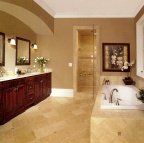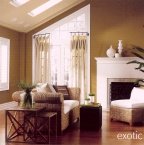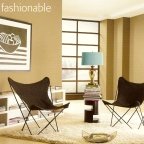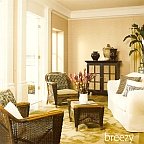5 Keys to Successful
Neutral Color Combinations
Successful neutral color combinations look easy. But in reality, neutral color schemes often take even more time to create than "real" color palettes.
Most harmonious, beautiful and interesting neutral color palettes have the following 5 characteristics in common - use them as a guideline when creating your own:
Undertones

When combining neutral paint colors with other neutrals in your decor, it's important to make sure their undertones complement each other or are the same.
For example, this foyer is painted in 3 shades of taupe which share the same green undertone. The yellow undertones of the other neutrals (the wood and chest) complement the paint colors nicely.
See "Beige Paint Color Undertones" to learn more about this aspect of color.
Contrast

Without enough contrast, all-neutral color combinations can turn out bland and boring.
Variation in value (lightness/darkness) adds depth and dimension.
Take a look at this bathroom: the colors of the walls, tile and counters play off each other and keep the eye moving.
Texture

Texture is another way to add variation to a neutral palette.
A heavily textured fabric or a rug will appear darker than the same color on the walls.
Mixing different textures (smooth and shiny, matte and dull, fine and heavy) will keep the room pulled together and interesting at the same time.
Punctuation

Just like our language needs punctuation, so does home color design.
And strategically placed touches of black, white or strong hues serve as commas, suspension points and even exclamation marks!
So whatever you want to say, you can always say it with color.
Pattern

In decorating, pattern is like spice.
It's what makes neutral color combinations unique, adds character, sets the tone and tells the story of what you and your room are all about.
But to be effective, it must be used sparingly - too much of a good thing is never good.









Leave a Comment: